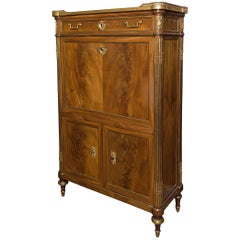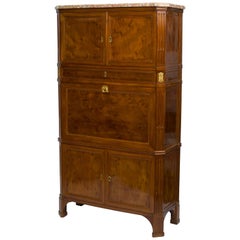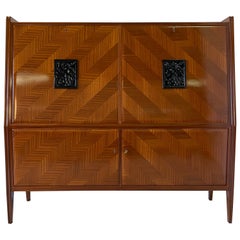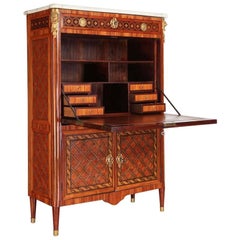Antiques Period LLC Secretaires
to
1
Height
to
Width
to
Depth
to
2
2
2
2
1
1
2
2
2
2
2
1
Louis XVI Ormolu-Mounted Mahogany Secretaire Stamped Sotto
Located in Kittery Point, ME
With a canted white marble rectangular top with a three-quarter pierced gallery above a frieze drawer, the fall-front with gilt-tooled black leather writing surface enclosing a fitte...
Category
Antique Late 18th Century French Louis XVI Secretaires
Materials
Mahogany
$12,000 Sale Price
20% Off
Louis XVI Ormolu-Mounted Mahogany Secrétaire en Cabinet by Jean-Francois Leleu
By Jean-François Leleu
Located in Kittery Point, ME
The later breccia marble top over two paneled doors opening to reveal shelves, above a drawer over a fall front with an interior fitted with drawers and compartments, and two further...
Category
Antique Late 18th Century French Louis XVI Cabinets
Related Items
Italian Mahogany Secretaire Cabinet, 1950s
Located in Meda, MB
Precious cabinet secretaire produced in Italy in the 1950s,
The whole cabinet is veneered in mahogany with a fine solid wood carving in the center of the two doors representing two b...
Category
Vintage 1950s Italian Mid-Century Modern Cabinets
Materials
Mahogany, Maple
French Ormolu-Mounted Marqueterie Secretaire Abattant, Cabinet, 1775
Located in Rome, IT
Important French ormolu-mounted, kingwood, tulipwood and stained sycamore marqueterie and parquetry secretaire abattant with rectangular moulded white marble top, above a frieze draw...
Category
Antique 18th Century French Louis XVI Secretaires
Materials
Wood
$29,828 Sale Price
20% Off
H 55.91 in W 37.01 in D 15.75 in
Fine French Ormolu-Mounted Marqueterie Secretaire Abattant
Located in Rome, IT
A fine French ormolu-mounted, kingwood , tulipwood and stained sycamore marqueterie and parquetry secretaire abattant with rectangular moulded white marble top , above a frieze drawe...
Category
Antique 18th Century and Earlier French Louis XVI Secretaires
Materials
Fruitwood
$28,948 Sale Price
13% Off
H 55.91 in W 37.01 in D 15.75 in
Baroque Cabinet with Secretaire, Germany 1750
Located in Belmont, MA
Add timeless elegance to your home or office with this original Baroque cabinet featuring a built-in secretary desk, crafted in Germany circa 1750. This exquisite piece originates fr...
Category
Antique 1750s German Baroque Cabinets
Materials
Walnut
Art Deco Secretaire Cabinet by Jules Deroubaix
By Jules Deroubaix
Located in North York, ON
This Jules Deroubaix display cabinet secretaire is timeless, functional, and effortlessly chic. Made of burl sandalwood, it showcases a drop door paneled wit...
Category
Vintage 1930s French Art Deco Secretaires
Materials
Brass, Chrome
Biedermeier Drawers Writing Desk Secrétaire Cabinet Swedish Ormolu Detail
Located in Lewes, England
Swedish antique Biedermeier writing desk chiffonier secrétaire cabinet in highly quilted golden birch veneers and finished in the Classic light honey color French polish.
It has 2 m...
Category
Antique Late 19th Century Swedish Biedermeier Secretaires
Materials
Birch
$4,254 Sale Price
20% Off
H 38.98 in W 36.23 in D 17.72 in
18th Century, French Louis XVI Inlaid Wood Secretaire with Marble Top
Located in IT
18th century, French Louis XVI inlaid wood secretaire with marble top and gilt bronzes.
This elegant secretaire Louis XVI was made in F...
Category
Antique Late 18th Century French Louis XVI Secretaires
Materials
Bronze
$19,217
H 56.7 in W 39.38 in D 15.75 in
18th Century Mahogany Secretaire Bookcase China Cabinet
Located in Lymington, GB
A fine English mid-18th century mahogany secretaire / secretary / bookcase / china cabinet.
Of lovely, deep, rich color, patina and quality.
George III-period, circa 1760.
The bold, detachable, swan-neck pediment carved with 'Gothic' open fretwork, spiral rosettes and a dentil cornice.
The pediment is centred by a small platform below which is a fluted panel. The bookcase / china cabinet section with two, thirteen-pane glazed doors, with three original adjustable shelves with applied beadings for the display of china etc.
The base with a pull-out writing section fitted with small drawers, two of which have secret releases. These secret drawers are faced with blind-fret 'Gothic' tracery, and centred by a carved, shaped arch.
The base with three cock-beaded drawers, and raised on its original bracket feet which are faced with blind fret.
This fine, sophisticated and well-proportioned example of a secretaire / secretary / cabinet / desk / bookcase is remarkable for having survived in its original state including all swan-neck handles and locks.
Of superb quality, color, patination, and well figured throughout. With mahogany drawer linings: further confirmation of its superlative quality.
Measures:
42" wide (107 cm)
23" deep 58.5 cm)
95" high (241 cm) - without cartouche.
A related antique bureau cabinet...
Category
Antique 1740s English George III Cabinets
Materials
Mahogany
Regency Brass-Inlaid Rosewood Secretaire Cabinet
Located in Lymington, Hampshire
A Regency brass-inlaid rosewood secretaire cabinet, the rectangular top with a pierced galleried shelf with trellis work on the sides, above a secretaire drawer, banded with brass pa...
Category
Antique 1810s English Regency Cabinets
Materials
Brass
Special 19th Century Gilt Bronze Mounted Inlaid Parquetry Secretaire a Abattant
By Jean-Henri Riesener
Located in Long Island City, NY
A Special Late 19th Century Gilt Bronze Mounted Inlaid Parquetry Secretaire a Abattant
The shaped marble top above a long center frieze drawer with a large central bronze plaque of putti at play, the beautiful parquetry drop-down door centered with an elliptical gilt bronze panel depicting ”A Sacrifice to Love”, a classically dressed woman presenting an infant to Cupid, who stands on a pedestal, the plaque has ribbon tied flowers, the inside centered with a mirror surrounded by drawers and pigeonholes, the fall-front itself provides a black leather writing surface, the bottom doors opening to two more drawers and a shelf, the sides decorated with similar parquetry designs.
This piece is a copy of the 18th century Secretaire by Jean-Henri Riesener which is presently in the Wallace Collection...
Category
Antique Late 19th Century French Belle Époque Cabinets
Materials
Marble, Bronze, Ormolu
$38,000
H 59 in W 43 in D 17 in
François Linke, Ormolu and Mahogany Secretaire After Riesener
By François Linke
Located in BARSAC, FR
Large Louis XVI style secretaire in mahogany marquetry in frames of light wood and ebony fillets, rich ornamentation of very finely chiseled gilt bronze such as flower garlands, inte...
Category
Antique Late 19th Century French Louis XVI Secretaires
Materials
Ormolu
$17,470
H 63.78 in W 41.74 in D 16.54 in
Elegant Louis XVI Cherrywood Secrétaire Cabinet
Located in Los Angeles, CA
Elegant Louis XVI cherrywood secrétaire cabinet.
Category
Antique 18th Century and Earlier French Louis XVI Secretaires
Materials
Leather, Cherry



